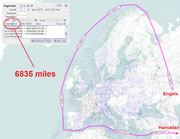THE SHORTER ANSWER
On the whole, the lend-lease accounted for only a small portion of Soviet combat armament (tanks, trucks, planes, ships, artillery pieces, etc.). That much is a fact, and Soviet-era propaganda never let that fact sleep in peace. However, these armaments, precisely the aid from Britain that arrived in late-1941, made a powerful impact in 1941–1942 (especially during the Battle of Moscow). And if the Soviets had lost at Moscow, it would have taken a much longer time for Germany to be defeated, if at all. In addition, the lend-lease accounted for a sizable portion of Soviet war amenities and materiel, like gasoline, aluminum, explosive agents (this in particular was VERY significant), steel (this in particular was decisive), non-perishable food, etc.
THE LONGER ANSWER
Tanks:
At the outbreak of war in June 1941, the USSR had roughly 22,600–23,100 tanks and self-propelled guns [MK][BVS] (the largest tank force in the world at the time) against Germany's invading force of 3,350 [DG1]. This opened the Eastern Front of WWII. In total, Germany had 5,639 tanks and assault guns at the time, but did not deploy all of them for the invasion [PB].
In several classic battles of encirclement, the Germans wiped out the Soviet prewar armada of tanks – an estimated 20,500 were lost by the end of December 1941[K]. The Germans, on the other hand, were in a very bad shape as well. They were left with only 35% of their initial tank strength (~1,100 tanks) in the Eastern Front by the end of October [DG2], many of which would be lost to attrition and winter-induced defects in the following two months. The two titans were at their limit, and this is where the British Lend-Lease Aid of 1941 (which began in October) helped to turn the tide. In an interesting paper published in the official peer-reviewed journal of the Society for Military History, Alexander Hill convincingly showed that:
British-supplied tanks made up in the region of 30 to 40 percent of the heavy and medium tank strength of Soviet forces before Moscow at the beginning of December 1941, and that they made up a significant proportion of such vehicles available as reinforcements at this critical juncture [AH].
But this important detail is lost in the big picture where the USSR produced 102,500 tanks and self-propelled guns for the whole war (according to the official Soviet history of the Great Patriotic War, completed in 1965) [AH], whereas the US, Britain and Canada altogether supplied only 12,537 tanks and self-propelled guns [BVS]. This means the Lend-Lease aid accounts for only 11% of tanks. But the same Soviet account declared that Lend-Lease aid only amounted to 7% of tanks; and unfortunately you'll see this figure alongside, 1.9% for all artillery, 13% for aircraft and 4% for total military production, floating around on the internet (all are from the same official Soviet account).
In 2007, the renowned Russian historian Boris Vadimovich Sokolov published a paper in a highly reputed peer-reviewed journal that thoroughly trashed this Soviet-era propaganda tract. Using production reports and declassified documents, he also thoroughly showed that the figure of 100,000+ tanks is likely a serious inflation, and that the actual proportion from Lend-Lease aid is around 24% [BVS]. If you can get your hands on Sokolov's paper (requires subscription to the online database Taylor & Francis), it will completely answer all your questions. I'm so tempted to upload and share it here, but that would be a copyright violation.
Unfortunately I'm running late, so I'll keep the rest brief. Sorry!
Aircraft
Official public Soviet-era figures all place the proportion of Lend-Lease aid at 13–15%. Sokolov's analysis places it at ~30%.
Fuel
The US, Britain and Canada supplied the USSR with 2.586 million tonne of aviation fuel and light-fraction gasoline, 1.4 times greater than the Soviet production during the war [BVS]. That was a very big boost to the Soviet Air Force.
Explosives
Sokolov stated the following:
Allied supplies of powder and explosive materials also played an important role. We assess the production of explosive materials in the USSR during the period from mid-1941 to mid-1945 as approximately 600,000 tons. No less than 295,600 tonne of explosive materials were supplied by the US. In addition, 22,300 tons of powder were supplied by Great Britain and Canada. Thus, Western deliveries of explosive materials reached 53 per cent of the total volume of Soviet production.
Tires
Sokolov stated the following:
We must also note that American deliveries played an essential role in the supply of the USSR with tire covers (outer tires) and separate types of food-stuffs. Lend-Lease supplied the Soviet Union with 3,606,000 tire covers, at the same time that the Soviet industry of 1941–45 delivered 8,368,000 tire covers (which included only 2,884,000 of the large tire covers named "Gigant"), while in 1945 vehicle tire cover production constituted 1,370,000 in comparison with 3,389,000 in 1941. American deliveries amounted to 43.1 per cent of Soviet production.
References
[MK] Martin Kahn. Russia Will Assuredly Be Defeated: Anglo-American Government Assessments of Soviet War Potential before Operation Barbarossa. (Peer-reviewed journal article). Link:
http://www.tandfonline.com/doi/full/10. ... 012.676498.
[PB] Pier Battistelli (2008). Panzer Divisions: The Eastern Front 1941-43. (Book). Page 65.
[K] Grigory Krivosheev, Soviet Casualties and Combat Losses in the Twentieth Century. Page 252
[DG1] David Glantz (2010). Barbarossa Derailed: The Battle for Smolensk – Volume 1. (Book). Page 20.
[DG2] David Glantz (2012). Operation Barbarossa: Hitler’s Invasion of Russia 1941. (Book). Page 183.
[AH] Alexander Hill (2007). British Lend-Lease Aid and the Soviet War Effort, June 1941–June 1942. (Peer-reviewed journal). The Journal of Military History: Vol. 71, issue 3.
[BVS] Boris V. Sokolov (2007). The role of lend‐lease in Soviet military efforts, 1941–1945. (Peer-reviewed journal). The Journal of Slavic Military Studies: Vol. 7, issue 3, pages 567-586. (Originally published in Russian in 1994).






